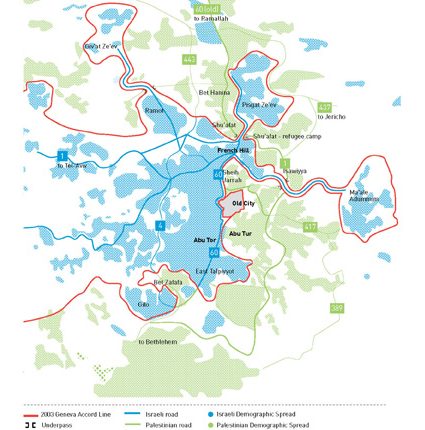by Hillel Fendel and Chaim Silberstein, www.KeepJerusalem.org
More than 16 years after the publication of the Geneva Initiative delineating a physical border in the heart of Jerusalem, those who dreamed it up are having second thoughts.
The Geneva Initiative was a non-binding “peace agreement” formulated in 2003 by Yossi Beilin and Yasser Abed Rabbo and their teams. It was originally a 50-page document detailing what the authors felt peace between Israel and the PA would look like, with dozens more pages added several years later. Essentially, the initiative calls for a non-militarized Palestinian state in practically all of Judea, Samaria and Gaza, with its capital in divided Jerusalem.
 The division of the Holy City, according to the Geneva plan, would be underscored with three crossing points between Israel and the Arab state smack inside the city: one crossing in French Hill, another one just north of the Old City, and a third one near Gilo. If that sounds unimaginable to anyone who has ever spent any time in Jerusalem, their ears serve them well; it is most definitely unimaginable.
The division of the Holy City, according to the Geneva plan, would be underscored with three crossing points between Israel and the Arab state smack inside the city: one crossing in French Hill, another one just north of the Old City, and a third one near Gilo. If that sounds unimaginable to anyone who has ever spent any time in Jerusalem, their ears serve them well; it is most definitely unimaginable.
And in fact, the Israeli team continuing to work on the plan has now written a paper saying that the original initiative appears to be “irrelevant” to the current reality in Jerusalem. Instead, they are considering a solution in which Jerusalem remains an “open” city, capital to two states at once. However – and this is a big caveat – the writers acknowledge that they do not know how, and if, security could be maintained under such an arrangement.
If they, who are anxious to divide the city, admit that there is no way to guarantee security to Israelis or Jewish Jerusalemites under such a plan, we certainly can’t argue with them.
Following the publication of the Trump Plan last month, it is universally understood that at least 30% of Yesha will remain Israeli. Yet, interestingly, the Geneva fellows have expressed no need to alter their plan from that standpoint, and continue to assume that a Palestinian state will arise in the entire area – even the space reserved for Israeli annexation.
However, their eyes have been opened to the many changes that have occurred that make a physical border in the city unworkable. These include the expansion of Jewish neighborhoods in eastern Jerusalem; infrastructures that cross under, over and through the proposed border; the security barrier that causes more Arabs to cross over to the Jewish side more frequently for various services; and the commercial inter-dependence of the two sides.
What’s also interesting is that though they cannot envision security in an open city that belongs both to an Israeli and Arab state, they continue to present this option as if it were realistic. They propose that Jerusalem function as one city with an umbrella municipality, featuring “close cooperation” between the two sides in enabling law and order enforcement by the two police forces and supervision of the crossings between the two “states.”
We’re not sure what finally awakened Israeli team member Prof. Michael Klein, but he now says as follows: “There are problems with the original agreement. For instance, life in the Old City [which was to have remained open to both sides] would be terrible. It’s not like the Vatican, which can be closed; there are tens of thousands of people, with markets and the like; it’s not a museum.”
We can only agree that having two states jointly run the Old City is a recipe for catastrophe. We then take it one step further in averring that applying this same futile approach to the entire city, east and west, would be many times worse.
As even Haaretz correspondent Nir Hasson has written, a jointly-run Jerusalem would have to be isolated from the rest of Israel by tight borders in order to assure that people and goods from the Arab state not cross freely into the Jewish State. Similarly, the city would be separated from the “mainland” Arab state – and Israel would have to rely on the PA security forces to oversee the crossings there. It’s actually fascinating that intelligent people consider this a workable idea.
True, Jerusalem today is an open city to both Jews and Arabs. But they all live and work under one clear sovereignty; they know that Israel is boss. But when sovereignty is shared, authorities have to be divided and delineated, and border crossings have to be built – and that’s where the problems, and grave dangers, begin.
Let us conclude with an upbeat and brief expansion of one of the above points: the welcome and blessed expansion of Jewish neighborhoods. Work on the 13 newest buildings in the community of Nof Tzion – 176 apartments that were approved back in October 2017 – has been briskly underway for the past few months. When completed, Nof Tzion will be nearly tripled in size (!).
Only eight years old and located outside Talpiyot Mizrach, Nof Tzion is the easternmost Jewish community in Jerusalem south of the Old City. Its panoramic views of the Temple Mount and dynamic communal character have made it most attractive for the religious-Zionist sector – despite its being nearly surrounded by Arab neighborhoods. Well over 300,000 Jews live in areas of Jerusalem liberated during the 1967 Six Day War.
In short, there is no justification for any type of division of Jerusalem, as the Jewish People have the historical, legal, moral and divine rights to the entire city, forever. Any form of division would disastrously embolden the Arabs in their Jihad quest to conquer the entire western world. By continuing to build Jewish neighborhoods in liberated Yerushalayim, Israel wisely prevents the calamitous division from taking place.
To participate in bus tours of in-the-news parts of Jerusalem, or to learn how to become a strong advocate for retaining united Yerushalayim under Jewish sovereignty, e-mail info@keepjerusalem.org, or visit Keep Jerusalem-Im Eshkachech at www.keepjerusalem.org


